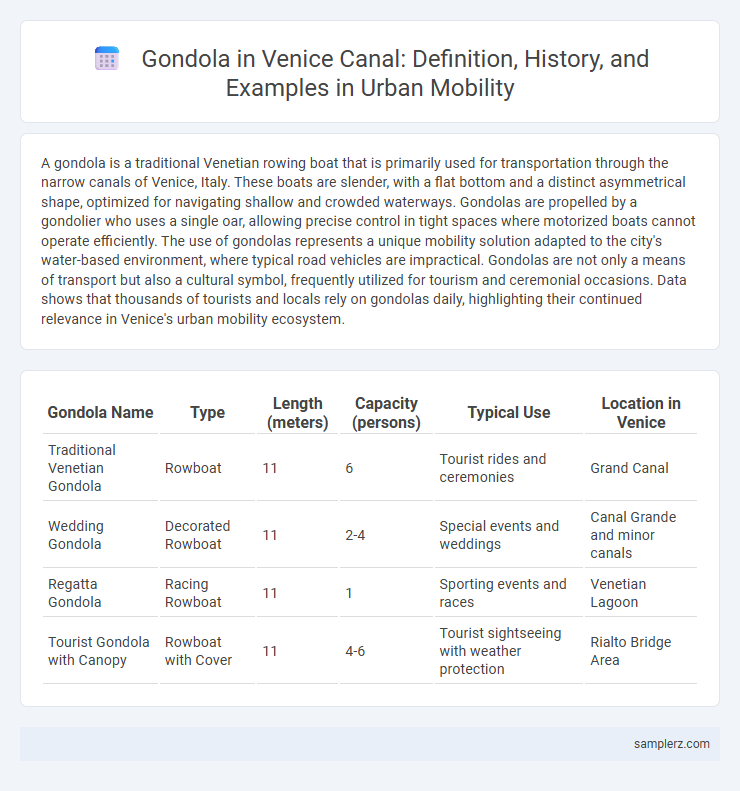A gondola is a traditional Venetian rowing boat that is primarily used for transportation through the narrow canals of Venice, Italy. These boats are slender, with a flat bottom and a distinct asymmetrical shape, optimized for navigating shallow and crowded waterways. Gondolas are propelled by a gondolier who uses a single oar, allowing precise control in tight spaces where motorized boats cannot operate efficiently. The use of gondolas represents a unique mobility solution adapted to the city's water-based environment, where typical road vehicles are impractical. Gondolas are not only a means of transport but also a cultural symbol, frequently utilized for tourism and ceremonial occasions. Data shows that thousands of tourists and locals rely on gondolas daily, highlighting their continued relevance in Venice's urban mobility ecosystem.
Table of Comparison
| Gondola Name | Type | Length (meters) | Capacity (persons) | Typical Use | Location in Venice |
|---|---|---|---|---|---|
| Traditional Venetian Gondola | Rowboat | 11 | 6 | Tourist rides and ceremonies | Grand Canal |
| Wedding Gondola | Decorated Rowboat | 11 | 2-4 | Special events and weddings | Canal Grande and minor canals |
| Regatta Gondola | Racing Rowboat | 11 | 1 | Sporting events and races | Venetian Lagoon |
| Tourist Gondola with Canopy | Rowboat with Cover | 11 | 4-6 | Tourist sightseeing with weather protection | Rialto Bridge Area |
Historical Significance of Gondolas in Venice Mobility
Gondolas have been a vital mode of transportation in Venice for over a thousand years, enabling residents to navigate the city's intricate canal network before the advent of motorized boats. These slender, flat-bottomed boats are expertly crafted to maneuver through narrow waterways, reflecting centuries of maritime tradition and local craftsmanship. The historical significance of gondolas lies in their role as both practical transport and cultural symbols, embodying Venice's unique relationship with water mobility.
Design Features of Traditional Venetian Gondolas
Traditional Venetian gondolas feature a distinctive asymmetrical hull designed for efficient navigation through narrow canals, enabling streamlined movement despite being rowed by a single oarsman. The ferro, an ornamental iron prow piece, not only serves a decorative purpose but also balances the boat's weight for stability. Crafted from multiple wooden components joined meticulously, these gondolas blend functionality with intricate artistry, reflecting centuries of Venetian maritime heritage.
Gondolas as a Sustainable Urban Transport Example
Gondolas in Venice canals exemplify sustainable urban transport by offering a zero-emission, human-powered alternative to motorized boats, reducing water pollution and noise in the historic city. These traditional vessels efficiently navigate narrow waterways, preserving the delicate ecosystem of Venice's lagoon while supporting local tourism and daily mobility. Their enduring design highlights the integration of cultural heritage and environmental sustainability in urban mobility solutions.
Iconic Gondola Routes through Venice Canals
Iconic gondola routes through Venice canals include the Grand Canal, offering views of historic palazzos like Ca' d'Oro and the Rialto Bridge. The route through the smaller, winding canals of the Cannaregio district highlights Venice's quiet residential charm. Navigating past St. Mark's Basin provides stunning vistas of the Doge's Palace and the Basilica di San Marco, making it a quintessential Venetian experience.
The Role of Gondoliers in Canal Navigation
Gondoliers in Venice play a crucial role in navigating the intricate canal network, expertly maneuvering gondolas with skillful oar strokes and deep knowledge of lagoon currents. Their navigation techniques rely on centuries-old traditions combined with modern awareness of water traffic regulations, ensuring safety and efficiency. As cultural ambassadors, gondoliers contribute to both the mobility infrastructure and the unique tourist experience of Venice.
Gondolas Versus Modern Water Taxis: A Mobility Comparison
Gondolas in Venice canals provide a traditional, slow-paced mode of transportation with limited passenger capacity, emphasizing cultural heritage and scenic experience. Modern water taxis offer faster, more efficient mobility with motorized engines and greater seating, catering to practical urban commuting needs. The contrast highlights the balance between preserving historic mobility methods and embracing contemporary transit solutions in Venice's unique aquatic environment.
Gondola Regulation and Preservation Efforts in Venice
Venice's gondola regulation enforces a strict licensing system, limiting the number of gondolas to preserve the city's historic waterways and minimize overcrowding. Preservation efforts include maintaining traditional craftsmanship through specialized gondolier training schools and government subsidies supporting restoration projects. These measures safeguard the cultural heritage and ensure sustainable mobility along Venice's iconic canals.
Gondolas in Venice: Tourist Attraction or Practical Transit?
Gondolas in Venice serve both as iconic tourist attractions and essential transit options for locals navigating the city's intricate canal network. These slender, flat-bottomed boats provide a unique mode of transportation suited to narrow waterways, offering efficient movement where traditional vehicles cannot operate. Their dual role enhances Venice's cultural heritage while supporting everyday mobility within its historic urban landscape.
Cultural Impact of Gondolas on Venetian Life
Gondolas in Venice serve as more than just transportation; they embody a centuries-old tradition integral to Venetian culture and identity. These iconic boats facilitate daily commuting through narrow canals while supporting local tourism, sustaining artisanship in boat-making and gondolier skills. Their presence enhances Venice's cultural heritage, symbolizing resilience amidst modern urban challenges and fostering a unique social fabric centered around waterborne mobility.
Future of Gondola Mobility Amid Environmental Challenges
The future of gondola mobility in Venice is rapidly evolving as environmental challenges such as rising water levels and pollution threaten traditional navigation. Innovations in electric propulsion and sustainable materials are being integrated to reduce emissions and preserve the fragile ecosystem of Venice's canals. These advancements aim to maintain the cultural heritage of gondolas while ensuring adaptive, eco-friendly transportation solutions for the city's unique waterways.

example of gondola in Venice canal Infographic
 samplerz.com
samplerz.com